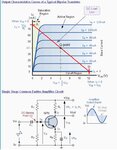aina_k
Newbie level 4
I am working on simulation of SiC bjt and simulating i-v characteristics of common emitter bjt. I have applied 2.5 volts at base and 25 volts at collector . My problem is that my curve dosen't start from zero i.e, it start from 0.6 volts. I donot understand the reason. Can anybody plz tell me the reason . I also have attached My Curve image so you people can easily understand the nature of my problem


